第二语言习得2
- 格式:ppt
- 大小:199.00 KB
- 文档页数:67


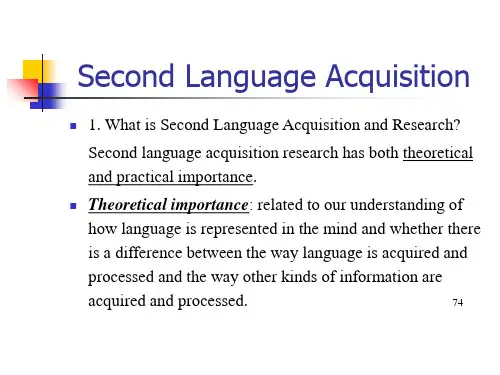
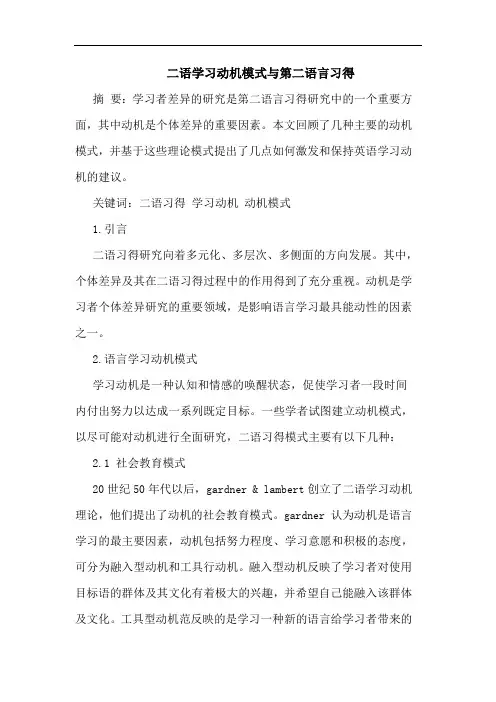
二语学习动机模式与第二语言习得摘要:学习者差异的研究是第二语言习得研究中的一个重要方面,其中动机是个体差异的重要因素。
本文回顾了几种主要的动机模式,并基于这些理论模式提出了几点如何激发和保持英语学习动机的建议。
关键词:二语习得学习动机动机模式1.引言二语习得研究向着多元化、多层次、多侧面的方向发展。
其中,个体差异及其在二语习得过程中的作用得到了充分重视。
动机是学习者个体差异研究的重要领域,是影响语言学习最具能动性的因素之一。
2.语言学习动机模式学习动机是一种认知和情感的唤醒状态,促使学习者一段时间内付出努力以达成一系列既定目标。
一些学者试图建立动机模式,以尽可能对动机进行全面研究,二语习得模式主要有以下几种:2.1 社会教育模式20世纪50年代以后,gardner & lambert创立了二语学习动机理论,他们提出了动机的社会教育模式。
gardner 认为动机是语言学习的最主要因素,动机包括努力程度、学习意愿和积极的态度,可分为融入型动机和工具行动机。
融入型动机反映了学习者对使用目标语的群体及其文化有着极大的兴趣,并希望自己能融入该群体及文化。
工具型动机范反映的是学习一种新的语言给学习者带来的实际价值和利益。
社会教育模式包括二语习得过程的四个方面:社会环境、个体差异变量、语言学习环境和学习结果。
在此模式中动机被视为语言学习中付出的努力和愿望以及对语言学习的积极态度。
2.2学习动机过程模式dornyei 是把动机过程研究引入二语习得领域的领路人,他认为,二语动机研究中许多争论和分歧很大程度上是由于对时间角度重视不够,二语学习动机研究应当和具体的学习行为和过程相结合,由此,他和otto(1998)构建了基于动机和时间关系的学习动机过程模式。
这一模式最初包括3个层面,即语言层面、学习者层面和学习环境层面。
dornyei首先将动机和具体的学习环境相结合,而且融入了认知心理学的价值观、信念等因素,提出了动机模式三层次说,后来又将这个动机三层次说完善为三的阶段:包括前行动、行动和后行动三个阶段。
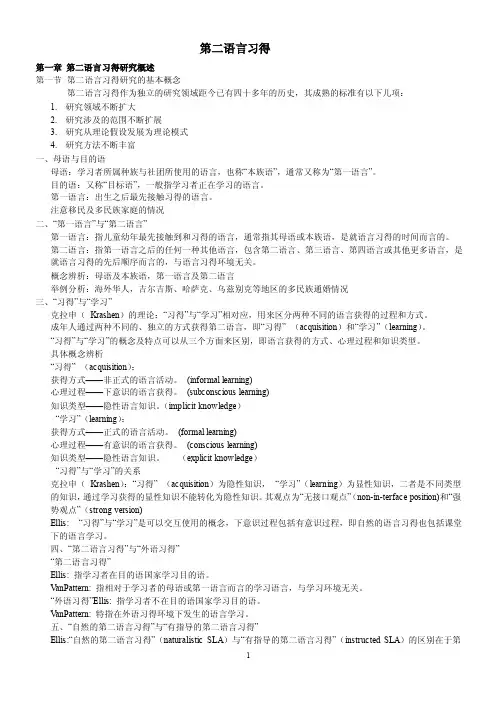
第二语言习得第一章第二语言习得研究概述第一节第二语言习得研究的基本概念第二语言习得作为独立的研究领域距今已有四十多年的历史,其成熟的标准有以下几项:1.研究领域不断扩大2.研究涉及的范围不断扩展3.研究从理论假设发展为理论模式4.研究方法不断丰富一、母语与目的语母语:学习者所属种族与社团所使用的语言,也称“本族语”,通常又称为“第一语言”。
目的语:又称“目标语”,一般指学习者正在学习的语言。
第一语言:出生之后最先接触习得的语言。
注意移民及多民族家庭的情况二、“第一语言”与“第二语言”第一语言:指儿童幼年最先接触到和习得的语言,通常指其母语或本族语,是就语言习得的时间而言的。
第二语言:指第一语言之后的任何一种其他语言,包含第二语言、第三语言、第四语言或其他更多语言,是就语言习得的先后顺序而言的,与语言习得环境无关。
概念辨析:母语及本族语,第一语言及第二语言举例分析:海外华人,吉尔吉斯、哈萨克、乌兹别克等地区的多民族通婚情况三、“习得”与“学习”克拉申(Krashen)的理论:“习得”与“学习”相对应,用来区分两种不同的语言获得的过程和方式。
成年人通过两种不同的、独立的方式获得第二语言,即“习得” (acquisition)和“学习”(learning)。
“习得”与“学习”的概念及特点可以从三个方面来区别,即语言获得的方式、心理过程和知识类型。
具体概念辨析“习得” (acquisition):获得方式——非正式的语言活动。
(informal learning)心理过程——下意识的语言获得。
(subconscious learning)知识类型——隐性语言知识。
(implicit knowledge)“学习”(learning):获得方式——正式的语言活动。
(formal learning)心理过程——有意识的语言获得。
(conscious learning)知识类型——隐性语言知识。
(explicit knowledge)“习得”与“学习”的关系克拉申(Krashen):“习得” (acquisition)为隐性知识,“学习”(learning)为显性知识,二者是不同类型的知识,通过学习获得的显性知识不能转化为隐性知识。
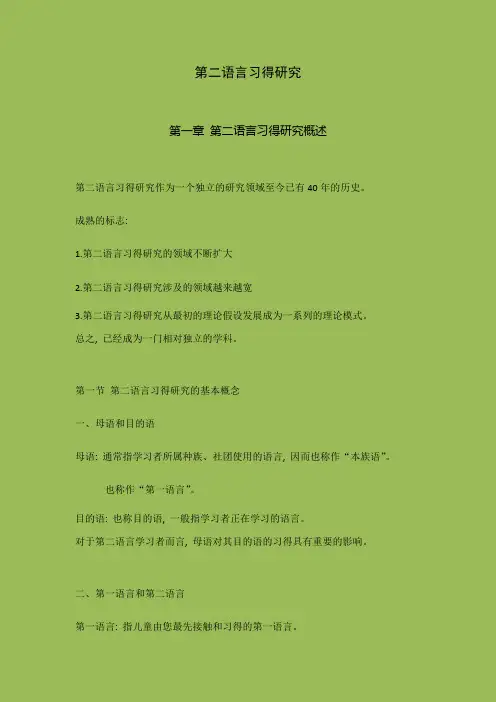
第二语言习得研究第一章第二语言习得研究概述第二语言习得研究作为一个独立的研究领域至今已有40年的历史。
成熟的标志:1.第二语言习得研究的领域不断扩大2.第二语言习得研究涉及的领域越来越宽3.第二语言习得研究从最初的理论假设发展成为一系列的理论模式。
总之, 已经成为一门相对独立的学科。
第一节第二语言习得研究的基本概念一、母语和目的语母语: 通常指学习者所属种族、社团使用的语言, 因而也称作“本族语”。
也称作“第一语言”。
目的语: 也称目的语, 一般指学习者正在学习的语言。
对于第二语言学习者而言, 母语对其目的语的习得具有重要的影响。
二、第一语言和第二语言第一语言: 指儿童由您最先接触和习得的第一语言。
第二语言: 是相对于学习者习得的第一语言之外的任何一种其他语言而言的。
第二语言的概念强调的是语言习得的先后顺序, 与语言习得的环境无关。
三、习得与学习这一对概念用来区分, 两种不同的语言获得的过程和方式。
习得: 类似于儿童母语的获得方式。
学习:指“正式”的语言规则学习, 及通过课堂教学的方式来获得第二语言。
四、第二语言习得与外语习得依据学习者语言习得环境来区分。
第二语言习得是指学习者在目的语国家学习目的语。
学习者所学目的语在该国家是工人的交际工具。
外语习得, 在课堂之外不作为交际工具。
五、自然的第二语言习得与有指导的第二语言习得语言获得方式和环境。
自然的第二语言习得是指以交际的方式获得第二语言。
有指导的第二语言习得是以教学指导的方式获得第二语言, 语言习得通常是在课堂教学环境中发生的。
六、语言能力与语言表达语言能力是由交际双方内在语法规则的心理表征构成的。
语言表达指的是交际双方在语言的理解与生成过程中对其内在语法的运用。
例: 你过来了吗?你说对的。
第二节第二语言习得研究的学科性质一、第二语言习得研究与语言学1.第二语言习得研究从诞生那天起, 就与语言学有一种天然的联系。
2.区别: 一方面, 就研究对象而言, 母语者的语言系统;学习者的语言系统另一方面, 研究目的不同,第三, 语言学家和第二语言习得研究者在分析和解释学习者语言系统的方法上也有所不同。

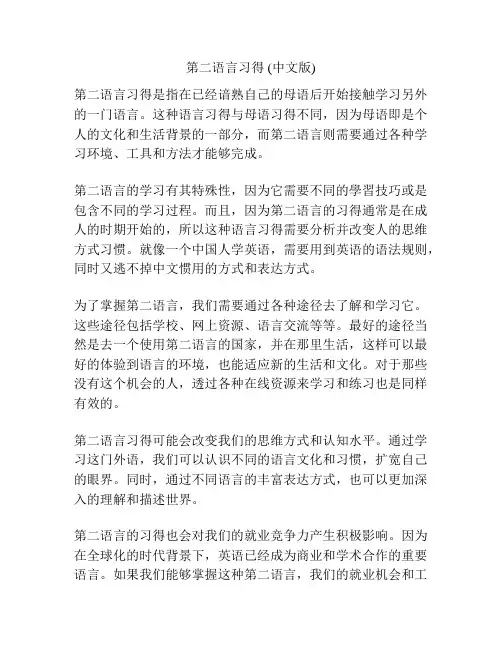
第二语言习得 (中文版)第二语言习得是指在已经谙熟自己的母语后开始接触学习另外的一门语言。
这种语言习得与母语习得不同,因为母语即是个人的文化和生活背景的一部分,而第二语言则需要通过各种学习环境、工具和方法才能够完成。
第二语言的学习有其特殊性,因为它需要不同的學習技巧或是包含不同的学习过程。
而且,因为第二语言的习得通常是在成人的时期开始的,所以这种语言习得需要分析并改变人的思维方式习惯。
就像一个中国人学英语,需要用到英语的语法规则,同时又逃不掉中文惯用的方式和表达方式。
为了掌握第二语言,我们需要通过各种途径去了解和学习它。
这些途径包括学校、网上资源、语言交流等等。
最好的途径当然是去一个使用第二语言的国家,并在那里生活,这样可以最好的体验到语言的环境,也能适应新的生活和文化。
对于那些没有这个机会的人,透过各种在线资源来学习和练习也是同样有效的。
第二语言习得可能会改变我们的思维方式和认知水平。
通过学习这门外语,我们可以认识不同的语言文化和习惯,扩宽自己的眼界。
同时,通过不同语言的丰富表达方式,也可以更加深入的理解和描述世界。
第二语言的习得也会对我们的就业竞争力产生积极影响。
因为在全球化的时代背景下,英语已经成为商业和学术合作的重要语言。
如果我们能够掌握这种第二语言,我们的就业机会和工作效率也会更高。
总之,第二语言习得是非常重要和有价值的。
这种习得需要时间、耐心和努力。
不过通过积极的学习和交流,我们能够顺利掌握一门外语,并获得更多的机会和认知。
第二语言习得的过程通常被认为是相对困难的,原因在于以下一些方面。
首先,个体的母语背景、学习历史和文化习惯对于学习另一门语言的效果产生重要影响。
这些因素往往会阻碍个体从母语中摆脱出来进入到新学习的语言环境中。
其次,学习语言的词汇和语法规则是一个长期而复杂的过程。
除了需要内化表达方式外,学习者还需要理解并适应新的文化习惯和社会背景。
而这种适应需要耗费大量的时间和精力。
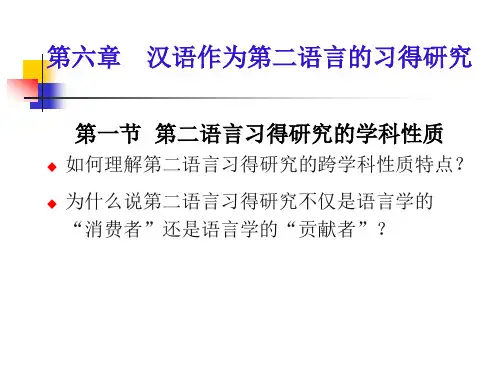
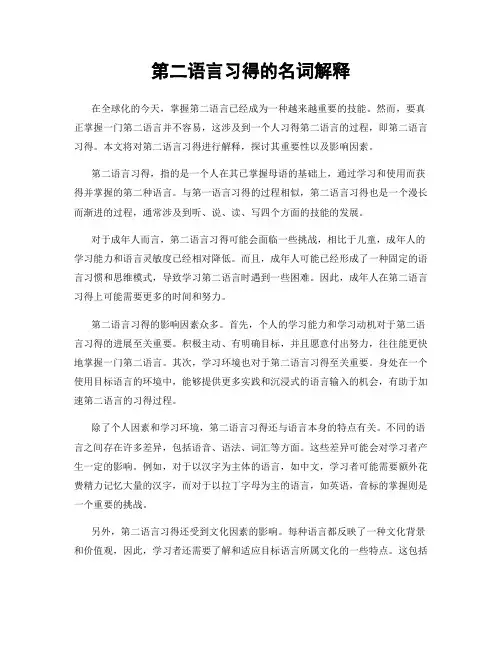
第二语言习得的名词解释在全球化的今天,掌握第二语言已经成为一种越来越重要的技能。
然而,要真正掌握一门第二语言并不容易,这涉及到一个人习得第二语言的过程,即第二语言习得。
本文将对第二语言习得进行解释,探讨其重要性以及影响因素。
第二语言习得,指的是一个人在其已掌握母语的基础上,通过学习和使用而获得并掌握的第二种语言。
与第一语言习得的过程相似,第二语言习得也是一个漫长而渐进的过程,通常涉及到听、说、读、写四个方面的技能的发展。
对于成年人而言,第二语言习得可能会面临一些挑战,相比于儿童,成年人的学习能力和语言灵敏度已经相对降低。
而且,成年人可能已经形成了一种固定的语言习惯和思维模式,导致学习第二语言时遇到一些困难。
因此,成年人在第二语言习得上可能需要更多的时间和努力。
第二语言习得的影响因素众多。
首先,个人的学习能力和学习动机对于第二语言习得的进展至关重要。
积极主动、有明确目标,并且愿意付出努力,往往能更快地掌握一门第二语言。
其次,学习环境也对于第二语言习得至关重要。
身处在一个使用目标语言的环境中,能够提供更多实践和沉浸式的语言输入的机会,有助于加速第二语言的习得过程。
除了个人因素和学习环境,第二语言习得还与语言本身的特点有关。
不同的语言之间存在许多差异,包括语音、语法、词汇等方面。
这些差异可能会对学习者产生一定的影响。
例如,对于以汉字为主体的语言,如中文,学习者可能需要额外花费精力记忆大量的汉字,而对于以拉丁字母为主的语言,如英语,音标的掌握则是一个重要的挑战。
另外,第二语言习得还受到文化因素的影响。
每种语言都反映了一种文化背景和价值观,因此,学习者还需要了解和适应目标语言所属文化的一些特点。
这包括语言之间的礼貌用语、社交习俗以及人际交往方式等方面。
只有通过了解并融入文化,才能真正地掌握第二语言。
虽然第二语言习得是一项艰巨的任务,但它也有许多好处。
首先,掌握第二语言可以为个人提供更多的就业机会。
在全球化的背景下,许多跨国公司需要员工掌握多种语言,能与不同国家的人进行交流。
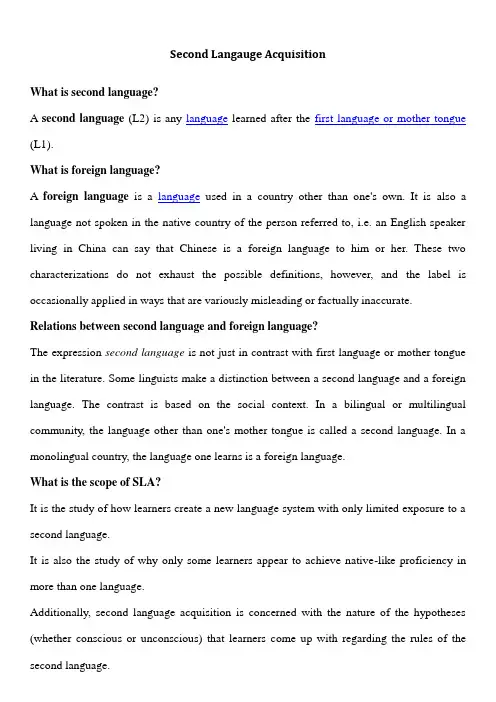
Second Langauge AcquisitionWhat is second language?A second language (L2) is any language learned after the first language or mother tongue (L1).What is foreign language?A foreign language is a language used in a country other than one's own. It is also a language not spoken in the native country of the person referred to, i.e. an English speaker living in China can say that Chinese is a foreign language to him or her. These two characterizations do not exhaust the possible definitions, however, and the label is occasionally applied in ways that are variously misleading or factually inaccurate. Relations between second language and foreign language?The expression second language is not just in contrast with first language or mother tongue in the literature. Some linguists make a distinction between a second language and a foreign language. The contrast is based on the social context. In a bilingual or multilingual community, the language other than one's mother tongue is called a second language. In a monolingual country, the language one learns is a foreign language.What is the scope of SLA?It is the study of how learners create a new language system with only limited exposure to a second language.It is also the study of why only some learners appear to achieve native-like proficiency in more than one language.Additionally, second language acquisition is concerned with the nature of the hypotheses (whether conscious or unconscious) that learners come up with regarding the rules of the second language.It is the study of what is learned of a second language and what is not learned; it is the study of why most second language learners do not achieve the same degree of knowledge and proficiency in a second language as they do in their native language.It is the study of how second languages are learned. In other words, it is the study of the acquisition of a non-primary language; that is, the acquisition of a language beyond the native language.A major goal of second language acquisition research is the determination of linguistic constraints on the formation of second language grammars. Because theories of language are concerned with human language knowledge, one can reasonably assume that this knowledge is not limited to first language knowledge, and that linguistic principles reflect the possibilities of human language creation and the limits of human language variation. This scope of inquiry includes second languages.Language pedagogypedagogical decision-making must reflect what is known about the process of learning, which is the domain of second language acquisition.Rationale related to language pedagogy has to do with the expectations that teachers have of their students.•Mr. Sung says “Let’s go”•Wexford: I wish you wouldn’t keep saying that. If I may suggest it, you should say, “Shall we go? Or “Are you ready?”•Sung: Y ou may suggest. Thank you. I am anxious to speak good. Shall we go? Are you ready?•Wexford: Oh, yes, certainly.•Sung: Don’t reply, please. I practice. Shall we go? Are you leady? Good, I have got it.Come, let’s go. Are you ready to go to the site? Reply now, please.Cross-cultural CommunicationMany of the speech patterns that nonnative speakers use reflect their nonnativeness rather than characteristics of their personality.Cross-cultural CommunicationExample 1(1-1) From Goldschmidt (1996, p. 255)•NNS: I have a favor to ask you.•NS: Sure, what can I do for you?•NNS: Y ou need to write a recommendation for me.Example 2•An international student whom the professor did not know emailed to ask the professor for an appointment, stating that she was interested in the discipline of SLA.The professor wrote back with a suggestion of a time that they finally agreed on. The student arrived at the appointed time and said:•(1-2) NNS: Y ou wanted to see me?Language policy and language planning•(a) information about second language learning,•(b) the kinds of instruction that can be brought to bear on issues of acquisition,•(c) the realities and expectations one can have of such programs.Second language acquisition is a complex field whose focus is the attempt to understand the processes underlying the learning of a second language.Second language acquisition, while rightfully part of the humanities, is also part of the social sciences, defined (Merriam-Webster online) as “a branch of science that deals with the institutions and functioning of human society and with the interpersonal relationships of individuals a s members of society.”DefinitionsNative Language (NL): This refers to the first language that a child learns. It is also known as the primary language, the mother tongue, or the L1 (first language). In this book, we use the common abbreviation NL.•Target Language (TL): This refers to the language being learned.•Second Language Acquisition (SLA): This is the common term used for the name of the discipline. In general, SLA refers to the process of learning another language after the native language has been learned. Sometimes the term refers to the learning of a third or fourth language. The important aspect is that SLA refers to the learning of a nonnative language after the learning of the native language. The second language is commonly referred to as the L2. As with the phrase “second language,” L2 can refer to any language learned after learning the L1, regardless of whether it is the second, third, fourth, or fifth language.•Foreign Language Learning: Foreign language learning is generally differentiated from second language acquisition in that the former refers to the learning of a nonnative language in the environment of one’s native language (e.g., French speakers learning English in France or Spanish speakers learning French in Spain, Argentina, or Mexico). This is most commonly done within the context of the classroom. Questions for discussion 1• 1 A teacher has drilled students in the structure known as indirect questions:•Do you know where my book is?•Do you know what time it is?•Did he tell you what time it is?•As a direct result of the drills, all students in the class were able to produce the structure correctly in class. After class, a student came up to the teacher and asked, “Do you know where is Mrs. Irving?” In other words, only minutes after the class, in spontaneous speech, the student used the structure practiced in class incorrectly.Describe what you think the reason is for this misuse. Had the lesson been a waste of time? How might you go about finding answers to these questions?Questions for discussion 2Consider the distinction between second language acquisition and foreign language learning. Take the position that they are fundamentally different.Questions for discussion 3•9 In pairs, answer “True” or “False” to the fo llowing statements. Justify your responses. Once you come to a consensus, compare your answers to those of another pair.• a Any child without cognitive disabilities can learn any language with equal ease.• b Learning a second language is a matter of learning a new set of habits.• c The only reason that some people cannot learn a second or foreign language is that they are insufficiently motivated.d All children can learn a second language accent-freeQuestions for discussion 4• e No adult can learn a second language accent-free.• f All human beings have an innate capacity to learn language.•g V ocabulary is the most important part of learning a second language.•h V ocabulary is the most difficult part of learning a second language.•i Language instruction is a waste of time.•j Learning a second language takes no more time than learning a first language. Suggestions for additional reading•Inside Language. Vivian Cook. Edward Arnold (1997).•Language: Its Structure and Use, 5th ed. Edward Finegan. Heinle (2008).•An Introduction to Language, 8th ed. Victoria Fromkin, Robert Rodman and Nina Hyams. Heinle (2007).•Essential Introductory Linguistics. Grover Hudson. Blackwell (2000).•Linguistics: A Very Short Introduction. P. H. Matthews. Oxford University Press (2003).•Contemporary Linguistics: An Introduction. William O’Grady, John Archibald, Mark •Aronoff, and Janie Rees-Miller. Bedford/St. Martin’s Press (2005).•The Language Instinct: How the Mind Creates Language. Steven Pinker. Morrow (1994).•Linguistics: An Introduction. Andrew Radford, Martin Atkinson, David Britain,•Harald Clahsen, and Andrew Spencer. Cambridge University Press (1999).。
第一章第二语言习得研究概述埃利斯(1994)明确地将第二语言习得与外语习得的概念区分开来。
“第二语言习得”是指学习者在目的语国家学习目的语。
学习者所学的目的语在目的语国家是公认的交际工具,当然也是学习者用来交际的工具。
“外语习得”是指学习者在本国学习目的语。
学习者的目的语在本国不是作为整个社团的交际工具。
这种语言学习基本上是在课堂上进行的。
“语言能力”是由交际双方内在语法规则的心理表征构成的。
简单地说,语言能力是一种反映交际双方语言知识的心理语法。
这种语法是一种隐性的语言知识。
语言能力包括:1)能指出哪些声音或语素的组合是母语中可能存在的,哪些可能是不存在的。
2)能区别符合语法的句子和不符合语法的句子。
3)能区别出一些结构相同或相似,但实际意义却不同的句子。
4)能辨别出结构不同但意义有联系的句子。
5)能辨别出句子的歧义,即同一结构具有一个以上的释义。
6)能意识到句子之间的释义关系,即结构不同的句子具有相同的语义。
“语言表达”指的是交际双方在语言的理解与生成过程中对其内在语法的表现。
关于语言运用的知识。
理想的母语者根据“递归规则”生成无限递归的句子。
第二节二语习得研究的发展一、发展阶段(一)20世纪50-60年代:理论初创阶段(二)20世纪70年代:理论大发展阶段1.偏误分析2.中介语理论假设3.习得顺序研究4.监控模式5.文化适应模式(三)20世纪80年代中期:成熟阶段1.语言学视角2.社会语言学视角3.认知视角4.社会文化视角二、理论成熟的标志1. 调查研究的领域和涉及的领域扩大2. 由理论假设发展为理论模式3. 研究方法日益科学化三、汉语作为第二语言的习得研究的发展(一)80年代,汉语习得研究起步。
1984鲁键骥“中介语理论与外国人学习汉语的语音偏误分析”1985年,第一界国际汉语教学讨论会1987年,吕必松“加强对外汉语教学的理论研究”评价:取得了一定成果,但缺乏系统研究、分析方法不够严谨、疏于解释和评价。
克拉申第二语言习得理论引论在过去的三十几年中,为更好地理解人们的语言学习行为,应用语言学家提出了很多语言习得理论,并从心理学、社会学、语言学和教育学的角度对语言习得作出详细阐述。
其中影响最深的是美国应用语言学家克拉申(Stephan D. Krashen)提出的第二语言认知理论。
本文对克拉申的语言习得理论进行介绍和讨论。
一、克拉申的第二语言习得理论从传统意义上讲,第二语言习得分为两大流派:行为主义学说( behaviorism) 和固有观念学说(innatism) 。
前者认为学习者与其周围环境的交流导致语言习得的产生;后者强调人的内在的和先天的因素在语言学习中的重要性,认为人与生俱来具备一种语言机制( language acquisition de2vice) ,使得人们去自由地习得语言。
从20 世纪70年代起,克拉申便专注于第二语言习得的研究,经过多年的研究,于80 年代初发表其两大专著:《第二语言习得和第二语言学习》( Second LanguageAcquisition Second Language Learning) (1981) 和《第二语言习得的原则和实践》(Principles and Practicein Second Language Acquisition) (1982) ;同时于1982年与特雷尔(T. Terrell) 合作出版了《自然途径》(The Natural Approach) 一书。
在这三部著作中,克拉申通过对第二语言习得过程的分析,系统地阐述了他的语言习得理论。
克拉申的第二语言习得理论由以下五个假设组成: ①习得- 学得差异假设(acquisition2learninghypothesis) ; ②监检假设(monitor hypothesis) ; ③自然顺序假设(natural order hypothesis) ; ④输入假设(input hypothesis) ; ⑤情感过滤假设(affective2filterhypothesis) [1 ] 。
二语习得理论克拉申理论2010-12-20 09:47:22| 分类:专业学习| 标签:|字号大中小订阅近年来,西方在第二语言习得研究中取得了不少成果,也提出了各种理论,其中影响较大的要数克拉申的第二语言习得理论(又称“监控理论”)。
此理论主要由五大假说组成:习得/学得假说(the Acquisition/Learning Hypothesis),自然顺序假说(the Natural Order Hypothesis),监控假说(the Monitor Hypothesis),输入假说(the Input Hypothesis)和情感过滤假说(the Affective Hypothesis) [1] [2]一、克拉申的语言习得理论(一)习得/学得假说习得/学得假说是克拉申所有假说中最基本的一个,是其第二语言习得理论的基础。
这一假说认为:发展第二语言能力有两个独立的途径:“习得”是下意识过程,与儿童习得母语的过程,在所有的重要方面都是一致的;“学得”则是有意识过程,通过这一过程,可“了解语言”(即获得有关语言的知识)。
“习得”是潜意识(subconscious)过程,是注重意义的自然交际结果,正如儿童母语习得过程。
“学得”(learning),是有意识(conscious)的过程,即通过课堂教师讲授并辅之以有意识的练习、记忆等活动达到对所学语言的掌握。
Krashen认为成人学习第二语言可以通过两种方式——语言习得(language acquisition)和语言学得(language learning)。
语言是潜意识过程的产物。
这一过程和孩子们学习母语的过程很相似。
它要求学习者用目的语进行有意义的、自然的交流。
在交流过程中学习者所关注的是交流活动本身,而不是语言形式。
语言习得则是正式教育的产物。
正式教育是一个有意识的过程,其结果是学习者能获得一些有意识的和语言相关的知识。
Krashen指出学得不能转换成习得。